battery FIAT DOBLO COMBI 2018 Owner handbook (in English)
[x] Cancel search | Manufacturer: FIAT, Model Year: 2018, Model line: DOBLO COMBI, Model: FIAT DOBLO COMBI 2018Pages: 272, PDF Size: 23.75 MB
Page 112 of 272
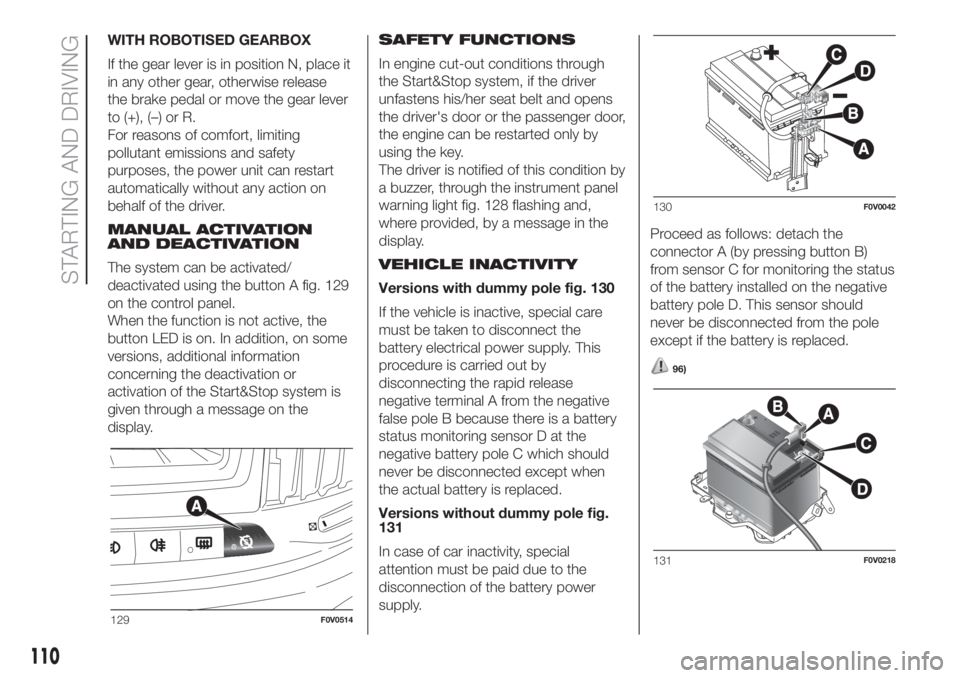
WITH ROBOTISED GEARBOX
If the gear lever is in position N, place it
in any other gear, otherwise release
the brake pedal or move the gear lever
to (+), (–) or R.
For reasons of comfort, limiting
pollutant emissions and safety
purposes, the power unit can restart
automatically without any action on
behalf of the driver.
MANUAL ACTIVATION
AND DEACTIVATION
The system can be activated/
deactivated using the button A fig. 129
on the control panel.
When the function is not active, the
button LED is on. In addition, on some
versions, additional information
concerning the deactivation or
activation of the Start&Stop system is
given through a message on the
display.SAFETY FUNCTIONS
In engine cut-out conditions through
the Start&Stop system, if the driver
unfastens his/her seat belt and opens
the driver's door or the passenger door,
the engine can be restarted only by
using the key.
The driver is notified of this condition by
a buzzer, through the instrument panel
warning light fig. 128 flashing and,
where provided, by a message in the
display.
VEHICLE INACTIVITY
Versions with dummy pole fig. 130
If the vehicle is inactive, special care
must be taken to disconnect the
battery electrical power supply. This
procedure is carried out by
disconnecting the rapid release
negative terminal A from the negative
false pole B because there is a battery
status monitoring sensor D at the
negative battery pole C which should
never be disconnected except when
the actual battery is replaced.
Versions without dummy pole fig.
131
In case of car inactivity, special
attention must be paid due to the
disconnection of the battery power
supply.Proceed as follows: detach the
connector A (by pressing button B)
from sensor C for monitoring the status
of the battery installed on the negative
battery pole D. This sensor should
never be disconnected from the pole
except if the battery is replaced.
96)
129F0V0514
130F0V0042
131F0V0218
110
STARTING AND DRIVING
Page 113 of 272
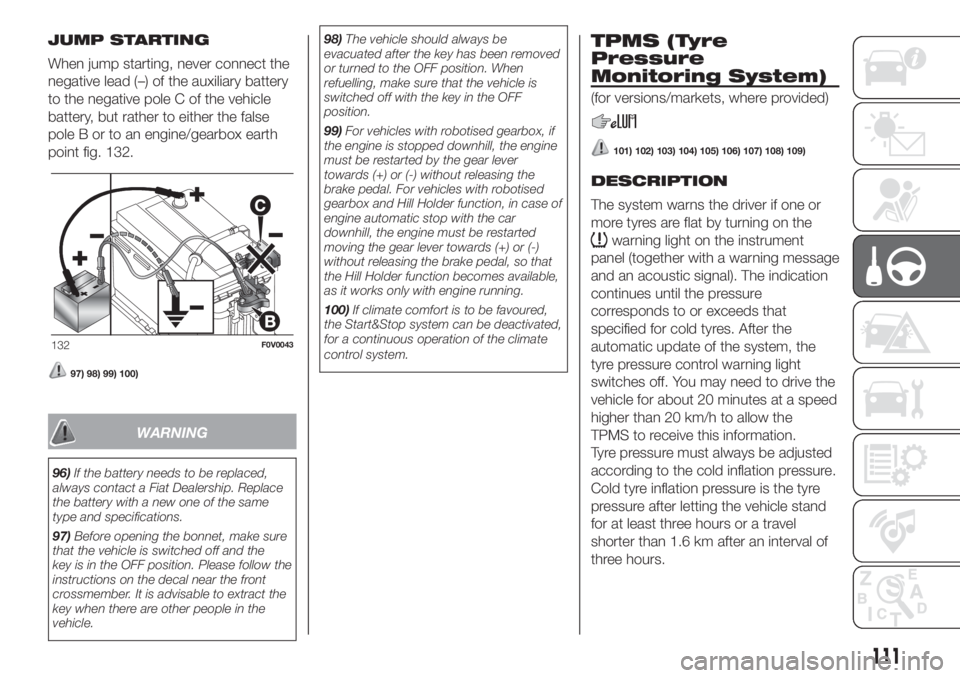
JUMP STARTING
When jump starting, never connect the
negative lead (–) of the auxiliary battery
to the negative pole C of the vehicle
battery, but rather to either the false
pole B or to an engine/gearbox earth
point fig. 132.
97) 98) 99) 100)
WARNING
96)If the battery needs to be replaced,
always contact a Fiat Dealership. Replace
the battery with a new one of the same
type and specifications.
97)Before opening the bonnet, make sure
that the vehicle is switched off and the
key is in the OFF position. Please follow the
instructions on the decal near the front
crossmember. It is advisable to extract the
key when there are other people in the
vehicle.98)The vehicle should always be
evacuated after the key has been removed
or turned to the OFF position. When
refuelling, make sure that the vehicle is
switched off with the key in the OFF
position.
99)For vehicles with robotised gearbox, if
the engine is stopped downhill, the engine
must be restarted by the gear lever
towards (+) or (-) without releasing the
brake pedal. For vehicles with robotised
gearbox and Hill Holder function, in case of
engine automatic stop with the car
downhill, the engine must be restarted
moving the gear lever towards (+) or (-)
without releasing the brake pedal, so that
the Hill Holder function becomes available,
as it works only with engine running.
100)If climate comfort is to be favoured,
the Start&Stop system can be deactivated,
for a continuous operation of the climate
control system.
TPMS (Tyre
Pressure
Monitoring System)
(for versions/markets, where provided)
101) 102) 103) 104) 105) 106) 107) 108) 109)
DESCRIPTION
The system warns the driver if one or
more tyres are flat by turning on the
warning light on the instrument
panel (together with a warning message
and an acoustic signal). The indication
continues until the pressure
corresponds to or exceeds that
specified for cold tyres. After the
automatic update of the system, the
tyre pressure control warning light
switches off. You may need to drive the
vehicle for about 20 minutes at a speed
higher than 20 km/h to allow the
TPMS to receive this information.
Tyre pressure must always be adjusted
according to the cold inflation pressure.
Cold tyre inflation pressure is the tyre
pressure after letting the vehicle stand
for at least three hours or a travel
shorter than 1.6 km after an interval of
three hours.
132F0V0043
111
Page 131 of 272
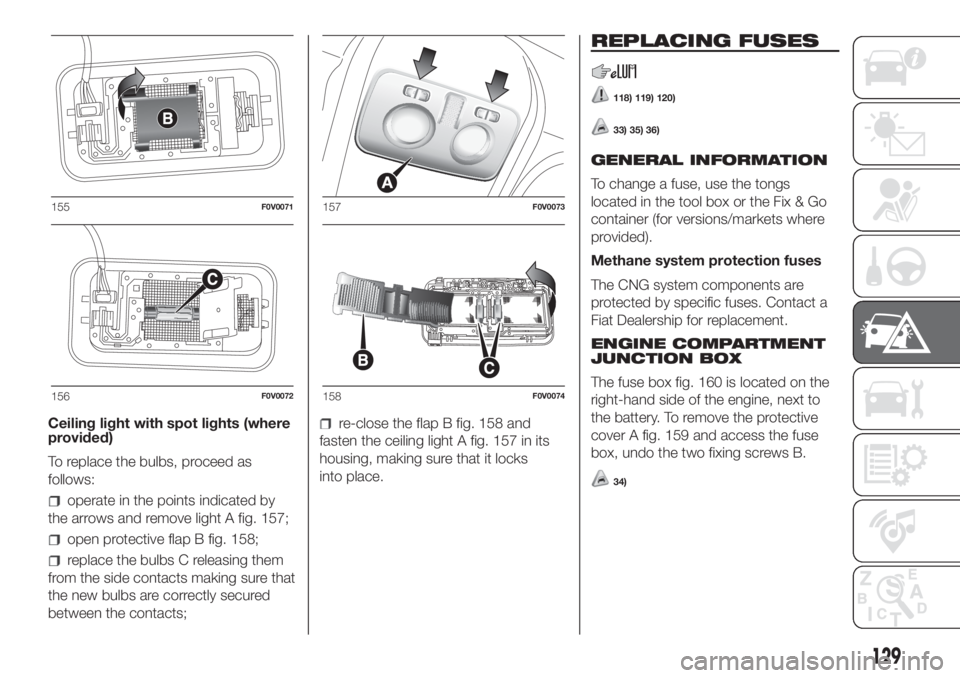
Ceiling light with spot lights (where
provided)
To replace the bulbs, proceed as
follows:
operate in the points indicated by
the arrows and remove light A fig. 157;
open protective flap B fig. 158;
replace the bulbs C releasing them
from the side contacts making sure that
the new bulbs are correctly secured
between the contacts;
re-close the flap B fig. 158 and
fasten the ceiling light A fig. 157 in its
housing, making sure that it locks
into place.
REPLACING FUSES
118) 119) 120)
33) 35) 36)
GENERAL INFORMATION
To change a fuse, use the tongs
located in the tool box or the Fix & Go
container (for versions/markets where
provided).
Methane system protection fuses
The CNG system components are
protected by specific fuses. Contact a
Fiat Dealership for replacement.
ENGINE COMPARTMENT
JUNCTION BOX
The fuse box fig. 160 is located on the
right-hand side of the engine, next to
the battery. To remove the protective
cover A fig. 159 and access the fuse
box, undo the two fixing screws B.
34)
155F0V0071
156F0V0072
157F0V0073
158F0V0074
129
Page 134 of 272
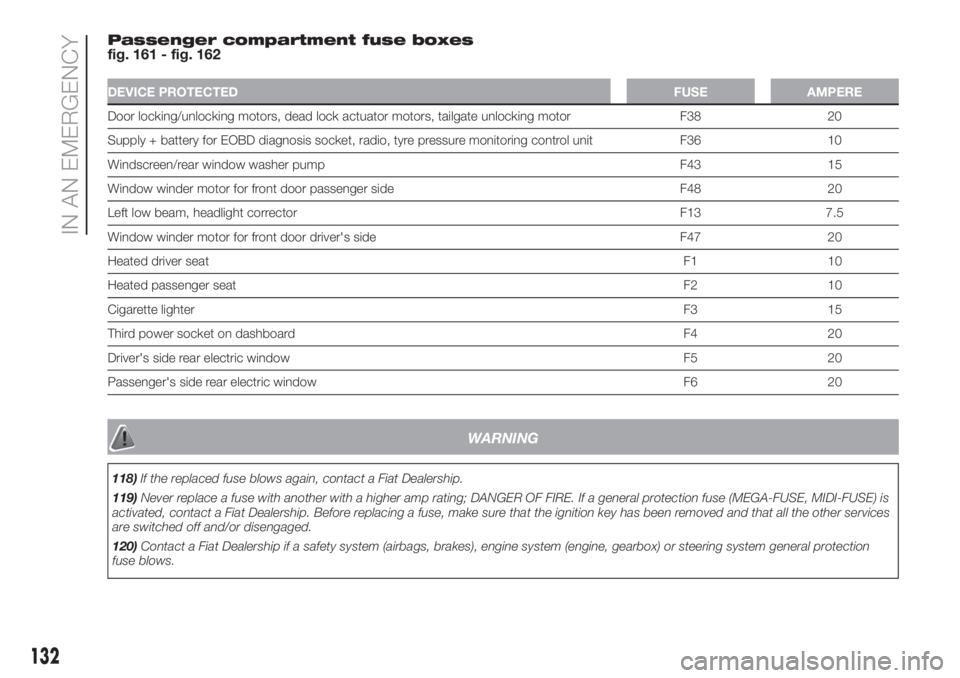
Passenger compartment fuse boxes
fig. 161 - fig. 162
DEVICE PROTECTEDFUSE AMPERE
Door locking/unlocking motors, dead lock actuator motors, tailgate unlocking motor F38 20
Supply + battery for EOBD diagnosis socket, radio, tyre pressure monitoring control unit F36 10
Windscreen/rear window washer pump F43 15
Window winder motor for front door passenger side F48 20
Left low beam, headlight corrector F13 7.5
Window winder motor for front door driver's side F47 20
Heated driver seatF1 10
Heated passenger seatF2 10
Cigarette lighterF3 15
Third power socket on dashboard F4 20
Driver's side rear electric window F5 20
Passenger's side rear electric window F6 20
WARNING
118)If the replaced fuse blows again, contact a Fiat Dealership.
119)Never replace a fuse with another with a higher amp rating; DANGER OF FIRE. If a general protection fuse (MEGA-FUSE, MIDI-FUSE) is
activated, contact a Fiat Dealership. Before replacing a fuse, make sure that the ignition key has been removed and that all the other services
are switched off and/or disengaged.
120)Contact a Fiat Dealership if a safety system (airbags, brakes), engine system (engine, gearbox) or steering system general protection
fuse blows.
132
IN AN EMERGENCY
Page 143 of 272
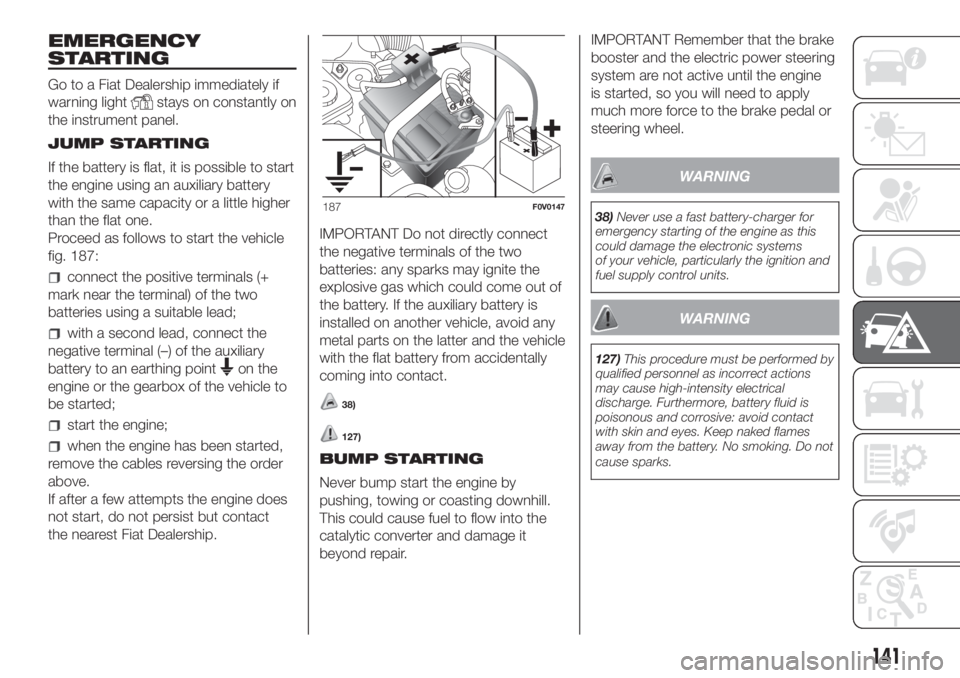
EMERGENCY
STARTING
Go to a Fiat Dealership immediately if
warning light
stays on constantly on
the instrument panel.
JUMP STARTING
If the battery is flat, it is possible to start
the engine using an auxiliary battery
with the same capacity or a little higher
than the flat one.
Proceed as follows to start the vehicle
fig. 187:
connect the positive terminals (+
mark near the terminal) of the two
batteries using a suitable lead;
with a second lead, connect the
negative terminal (–) of the auxiliary
battery to an earthing point
on the
engine or the gearbox of the vehicle to
be started;
start the engine;
when the engine has been started,
remove the cables reversing the order
above.
If after a few attempts the engine does
not start, do not persist but contact
the nearest Fiat Dealership.IMPORTANT Do not directly connect
the negative terminals of the two
batteries: any sparks may ignite the
explosive gas which could come out of
the battery. If the auxiliary battery is
installed on another vehicle, avoid any
metal parts on the latter and the vehicle
with the flat battery from accidentally
coming into contact.
38)
127)
BUMP STARTING
Never bump start the engine by
pushing, towing or coasting downhill.
This could cause fuel to flow into the
catalytic converter and damage it
beyond repair.IMPORTANT Remember that the brake
booster and the electric power steering
system are not active until the engine
is started, so you will need to apply
much more force to the brake pedal or
steering wheel.
WARNING
38)Never use a fast battery-charger for
emergency starting of the engine as this
could damage the electronic systems
of your vehicle, particularly the ignition and
fuel supply control units.
WARNING
127)This procedure must be performed by
qualified personnel as incorrect actions
may cause high-intensity electrical
discharge. Furthermore, battery fluid is
poisonous and corrosive: avoid contact
with skin and eyes. Keep naked flames
away from the battery. No smoking. Do not
cause sparks.
187F0V0147
141
Page 144 of 272
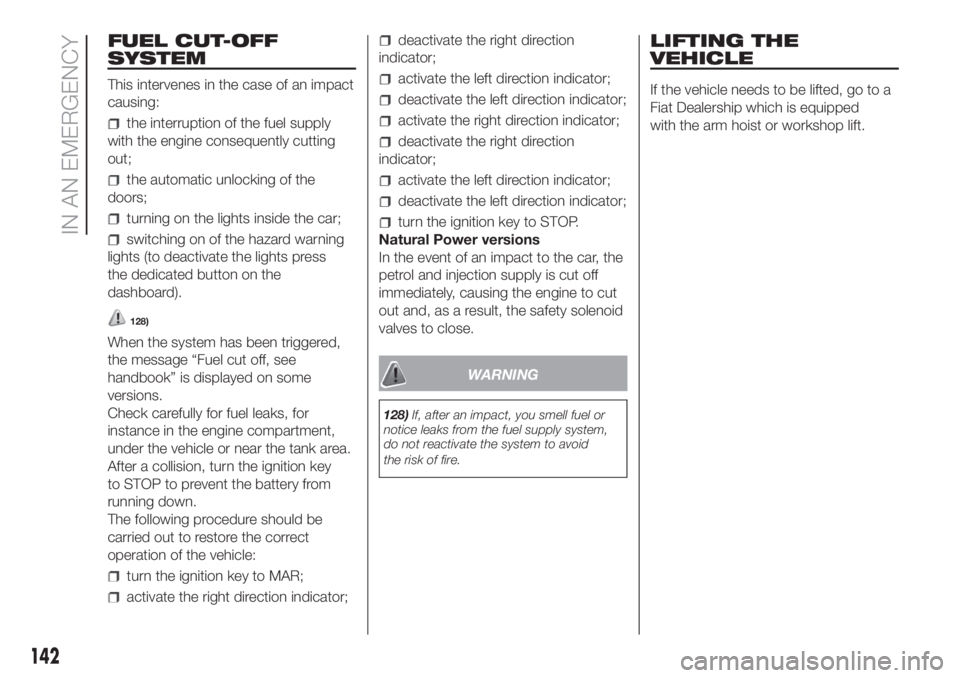
FUEL CUT-OFF
SYSTEM
This intervenes in the case of an impact
causing:
the interruption of the fuel supply
with the engine consequently cutting
out;
the automatic unlocking of the
doors;
turning on the lights inside the car;
switching on of the hazard warning
lights (to deactivate the lights press
the dedicated button on the
dashboard).
128)
When the system has been triggered,
the message “Fuel cut off, see
handbook” is displayed on some
versions.
Check carefully for fuel leaks, for
instance in the engine compartment,
under the vehicle or near the tank area.
After a collision, turn the ignition key
to STOP to prevent the battery from
running down.
The following procedure should be
carried out to restore the correct
operation of the vehicle:
turn the ignition key to MAR;
activate the right direction indicator;
deactivate the right direction
indicator;
activate the left direction indicator;
deactivate the left direction indicator;
activate the right direction indicator;
deactivate the right direction
indicator;
activate the left direction indicator;
deactivate the left direction indicator;
turn the ignition key to STOP.
Natural Power versions
In the event of an impact to the car, the
petrol and injection supply is cut off
immediately, causing the engine to cut
out and, as a result, the safety solenoid
valves to close.
WARNING
128)If, after an impact, you smell fuel or
notice leaks from the fuel supply system,
do not reactivate the system to avoid
the risk of fire.
LIFTING THE
VEHICLE
If the vehicle needs to be lifted, go to a
Fiat Dealership which is equipped
with the arm hoist or workshop lift.
142
IN AN EMERGENCY
Page 146 of 272
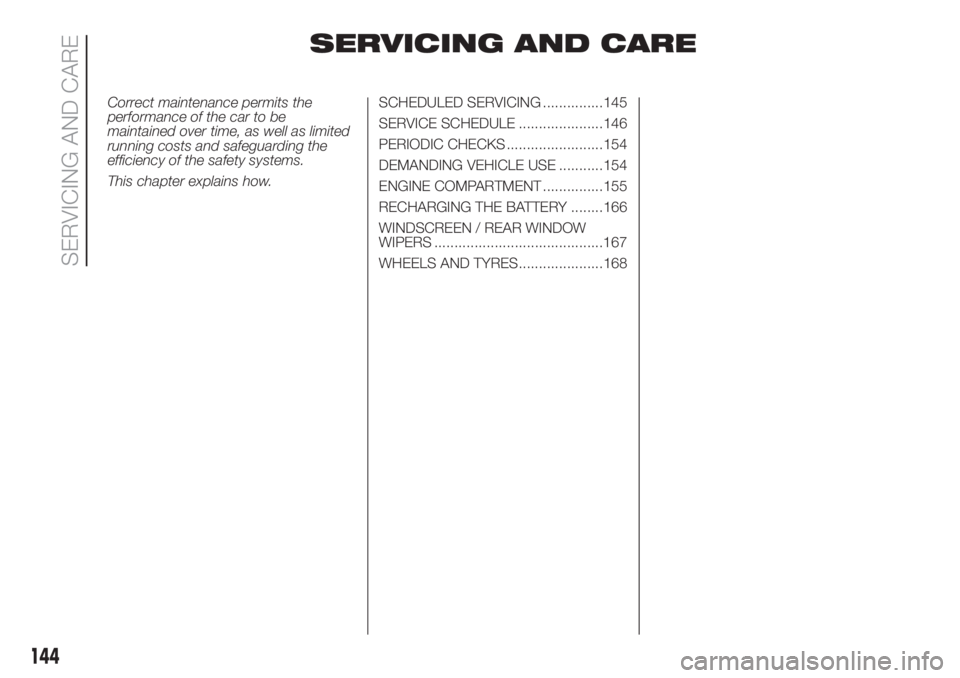
SERVICING AND CARE
Correct maintenance permits the
performance of the car to be
maintained over time, as well as limited
running costs and safeguarding the
efficiency of the safety systems.
This chapter explains how.SCHEDULED SERVICING ...............145
SERVICE SCHEDULE .....................146
PERIODIC CHECKS ........................154
DEMANDING VEHICLE USE ...........154
ENGINE COMPARTMENT ...............155
RECHARGING THE BATTERY ........166
WINDSCREEN / REAR WINDOW
WIPERS ..........................................167
WHEELS AND TYRES.....................168
144
SERVICING AND CARE
Page 148 of 272
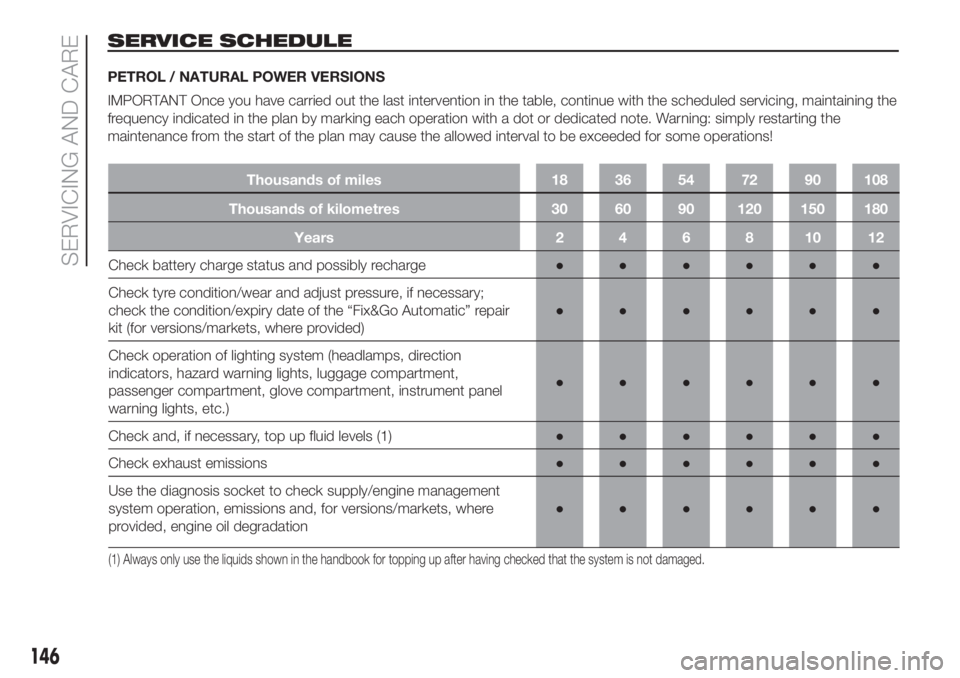
SERVICE SCHEDULE
PETROL / NATURAL POWER VERSIONS
IMPORTANT Once you have carried out the last intervention in the table, continue with the scheduled servicing, maintaining the
frequency indicated in the plan by marking each operation with a dot or dedicated note. Warning: simply restarting the
maintenance from the start of the plan may cause the allowed interval to be exceeded for some operations!
146
SERVICING AND CARE
Thousands of miles 18 36 54 72 90 108
Thousands of kilometres 30 60 90 120 150 180
Years 2 4 6 8 10 12
Check battery charge status and possibly recharge●●●●●●
Check tyre condition/wear and adjust pressure, if necessary;
check the condition/expiry date of the “Fix&Go Automatic” repair
kit (for versions/markets, where provided)●●●●●●
Check operation of lighting system (headlamps, direction
indicators, hazard warning lights, luggage compartment,
passenger compartment, glove compartment, instrument panel
warning lights, etc.)●●●●●●
Check and, if necessary, top up fluid levels (1)●●●●●●
Check exhaust emissions●●●●●●
Use the diagnosis socket to check supply/engine management
system operation, emissions and, for versions/markets, where
provided, engine oil degradation●●●●●●
(1) Always only use the liquids shown in the handbook for topping up after having checked that the system is not damaged.
Page 151 of 272
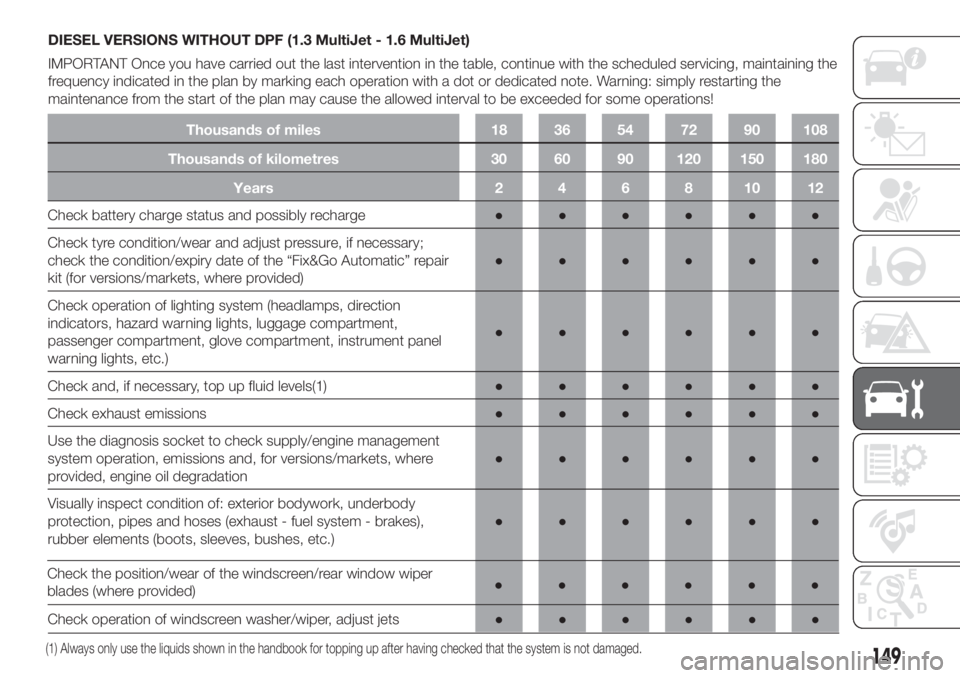
DIESEL VERSIONS WITHOUT DPF (1.3 MultiJet - 1.6 MultiJet)
IMPORTANT Once you have carried out the last intervention in the table, continue with the scheduled servicing, maintaining the
frequency indicated in the plan by marking each operation with a dot or dedicated note. Warning: simply restarting the
maintenance from the start of the plan may cause the allowed interval to be exceeded for some operations!
149
Thousands of miles 18 36 54 72 90 108
Thousands of kilometres 30 60 90 120 150 180
Years 2 4 6 8 10 12
Check battery charge status and possibly recharge●●●●●●
Check tyre condition/wear and adjust pressure, if necessary;
check the condition/expiry date of the “Fix&Go Automatic” repair
kit (for versions/markets, where provided)●●●●●●
Check operation of lighting system (headlamps, direction
indicators, hazard warning lights, luggage compartment,
passenger compartment, glove compartment, instrument panel
warning lights, etc.)●●●●●●
Check and, if necessary, top up fluid levels(1)●●●●●●
Check exhaust emissions●●●●●●
Use the diagnosis socket to check supply/engine management
system operation, emissions and, for versions/markets, where
provided, engine oil degradation●●●●●●
Visually inspect condition of: exterior bodywork, underbody
protection, pipes and hoses (exhaust - fuel system - brakes),
rubber elements (boots, sleeves, bushes, etc.)●●●●●●
(1) Always only use the liquids shown in the handbook for topping up after having checked that the system is not damaged.
Check the position/wear of the windscreen/rear window wiper
blades (where provided)●●●●●●
Check operation of windscreen washer/wiper, adjust jets●●●●●●
Page 153 of 272
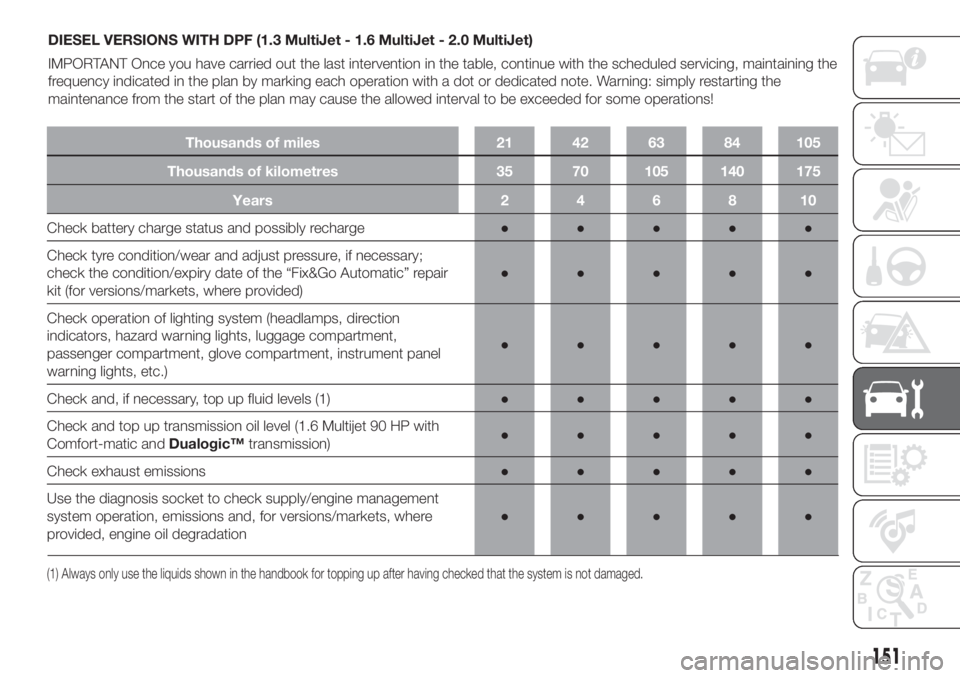
DIESEL VERSIONS WITH DPF (1.3 MultiJet - 1.6 MultiJet - 2.0 MultiJet)
IMPORTANT Once you have carried out the last intervention in the table, continue with the scheduled servicing, maintaining the
frequency indicated in the plan by marking each operation with a dot or dedicated note. Warning: simply restarting the
maintenance from the start of the plan may cause the allowed interval to be exceeded for some operations!
151
Thousands of miles 21 42 63 84 105
Thousands of kilometres 35 70 105 140 175
Years246810
Check battery charge status and possibly recharge●●●●●
Check tyre condition/wear and adjust pressure, if necessary;
check the condition/expiry date of the “Fix&Go Automatic” repair
kit (for versions/markets, where provided)●●●●●
Check operation of lighting system (headlamps, direction
indicators, hazard warning lights, luggage compartment,
passenger compartment, glove compartment, instrument panel
warning lights, etc.)●●●●●
Check and, if necessary, top up fluid levels (1)●●●●●
Check and top up transmission oil level (1.6 Multijet 90 HP with
Comfort-matic andDualogic™transmission)●●●●●
Check exhaust emissions●●●●●
Use the diagnosis socket to check supply/engine management
system operation, emissions and, for versions/markets, where
provided, engine oil degradation●●●●●
(1) Always only use the liquids shown in the handbook for topping up after having checked that the system is not damaged.